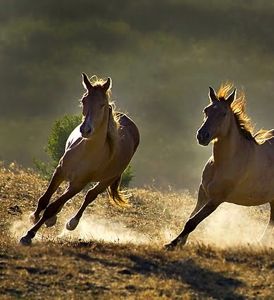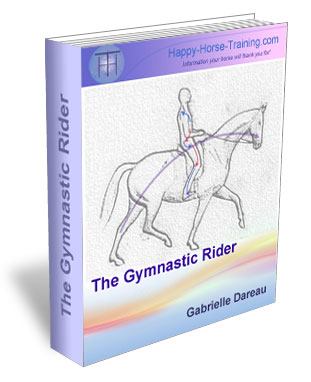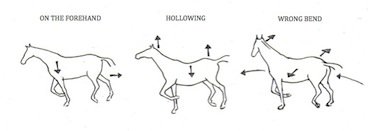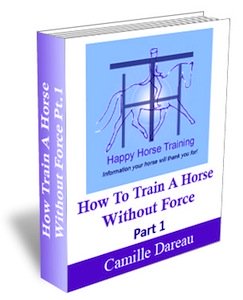| Back to Back Issues Page |
 |
|
Are these issues familiar? Their real cause is maybe not what you thought... June 06, 2018 |
Why Balance MattersThe Unspoken Root of a Plethora of Problems
This question threw me a little to begin with, because I wanted to answer ‘well obviously all horses are unbalanced if they haven’t had systematic training to address their posture and alignment!’. Then I got to thinking about this subject from beyond my own perspective, and I realised that of course it’s not always obvious to riders that their horse is unbalanced, and they won’t necessarily relate the issues they are having to this root cause. Common Assumptions About Training IssuesThe fact is that many problems, caused in reality by a fundamental lack of balance, are interpreted as something completely different. For example, it’s very easy to assume that the resistances you might come across in riding are a behavioural problem, or that they are caused by past experiences, bad training etc.It’s also easy to assume that you’re not moving forward in your horse’s training because of his/her basic conformational limitations. Or, on the other hand, it's common not see the real source of physical problems that are in fact caused or exacerbated by basic balance issues. This last point brings to mind the story of Octavia, a little Lipizzaner mare who came to HHT as a last alternative to being put to sleep due to a multitude of problems, including chronic ligament damage, hoof problems and severe 'resistances' such as rearing and nappiness when she was ridden. These issues were entirely produced by a combination of bad management (non-holistic lifestyle) and the immense stress put on her body and mind by being forced to do fairly advanced dressage when she was in reality completely unbalanced. With gymnastic training and holistic care she is now healthy and happy, and she has given great riding experiences to many HHT clients. You can read her full story here:
Octavia's story: Is an aggressive horse brave or just insecure?  It’s also all too tempting to fall for the traditional belief that you have to use forceful equipment (double bridles and other strong bits, spurs, and any kind of auxiliary aid such as draw-reins, training aids etc.) to resolve issues, or even simply to move to a more advanced level of training.
It’s also all too tempting to fall for the traditional belief that you have to use forceful equipment (double bridles and other strong bits, spurs, and any kind of auxiliary aid such as draw-reins, training aids etc.) to resolve issues, or even simply to move to a more advanced level of training.
I personally believe that the traditional dressage equipment is totally unnecessary to achieving any level of training, and that in truth this forceful equipment (no matter how supposedly 'sensitively is is used') is a way of covering up an underlying lack of postural connection and true balance.
The Bigger Picture of Balance(from my perspective)The truth is that the horse’s natural balancing mechanisms are not adapted to carrying a rider, so there is automatically a whole series of imbalances created as soon as we are in the saddle, or even when we ask a horse to turn on a circle on the lunge.
Even without the influence of having a rider onboard, we need to recognise the reality that horses do not naturally move in a biomechanically optimised way, with alignment, steady transmission and postural support.
This natural balance may be perfect for the demands of their wild state (the context horses have involved in during millions of years), but it includes four main characteristics that lead to balance problems in the context of the demands that we humans place on them.
Biomechanical Challenges in the Horse's Natural Balance:
These forms of imbalance are so hard-wired into the horse’s biomechancal nature that they will not be altered by our demands unless we make a conscious, systematic and suitably-adapted effort to address them on a postural level. What usually happens instead is a combination of the rider getting used to the various feelings of imbalance and finding ways of compensating for them, while the horse’s natural compensatory mechanisms not only remain unaddressed, but are reinforced in the struggle to find a compromise. But no matter how unaware we are of them or how well we unwittingly cover them up with traditional training practices, imbalances will always lead to problems, on many levels, within our interaction with the horse. They also come in the way of the wonderfully positive experience that riding becomes for both you and your horse when you have a truly balanced connection.
That’s a brief summary of my understanding of why every horse and every rider need to find balance through gymnastic training as the very basis of their activities together.
But What Does That Mean for the Average Rider?Coming back to that original question: what are the problems that tell us there are balance issues with your horse?I started to map out the issues that I know frequently arise between horse and rider stemming from an essential lack of balance. For simplicity's sake, I have organised them into three different categories: problems that manifest in the horse, problems that manifest in the rider, and problems that manifest in the training process. These three areas are, in reality, deeply interlinked, but instead of sticking to my usual perspective that comes from being experienced with the gymnastic approach, I want to really try to look at this from the point of view of ‘regular’ riders and the challenges they come up against. To keep it (relatively!) brief, I’m going to go into the details of these three areas separately in an upcoming series of newsletters, but for now I’ll give an overview of the various issues, some of which you might be able to identify with. Problems that manifest in the horse as a result of unbalanced riding and trainingPhysical issues:

Issues that Manifest as the Horse's Behaviour:
Riding issues:

Problems that manifest in the rider as a result of unbalanced riding and trainingYour Experience of Riding:
Problems that manifest in the training process
That's a lot of problems! Could they really all be related to balance? Well, yes - balance is such a fundamental part of riding that things can go wrong in many, many ways if it's not there. Remember that as individual species horse and human have evolved to deal with any imbalances that come about naturally, but neither of us have evolved to cope with the strain caused by imbalances of riding! What About the Holistic Perspective?Identifying the root of problems such as some of those I have just listed is often a complex matter and, each case needs to be considered individually.Experience of working with all kinds of 'problem' horses (and just ordinary, not-super-talented horses) over the years has shown me the wide-ranging and profound power of gymnastic training in solving all kinds of issues, even down to basic limitations in the way horses are put together. At the same time, if you’re familiar with HHT then you will know that it is a holistic approach that involves bringing together all aspects of the horse’s physical, mental and emotional state to find well-being. So of course there are many problems that require solutions beyond the context of riding and training. This includes, for example, the way horses are kept, their diet, physical issues that need to be addressed with therapy, and behavioural issues that require healing through work to restore mutual trust.
That’s why you will find many articles on all of these subjects on the HHT website (see the site plan!).

But I am also very aware that we can’t do everything at once to implement holistic well-being for our horses. Focusing on gymnastic training can be a powerful starting point for pursuing the holistic approach (as it was for us!), since it requires us to be present with our horses, and to recognise sources of tension and lack of wellbeing. Gymnastic training and riding for flow can also be a way to deeply enrich your relationship with your horse if you already have holistic care in place. Gymnastic training is not the solution to every problem, but it is an extremely powerful piece of the puzzle, and one which can open doors to other solutions thanks to its profound stimulation of the body as a whole. The reality is that this approach to working with your horse is a fairly challenging one, requiring you to develop many skills, so if you don’t focus on it for long enough you will never start to reap
the rewards!
If you’re interesting in exploring the gymnastic riding and training approach then stay posted as I explore, in following newsletters, each of the three different areas of challenges that you may already have encountered in working with your horse, and offer a new perspective on their true causes.
Just Click here to go to the HHT group page, and then click on the 'join group' button at the top right of the page.
Sharing the Holistic Message
If you enjoy the Happy Horse Training website please help us to share it by clicking on the Facebook 'like' and 'share' buttons that are on each page (you can also share this newsletter by clicking on the symbol above). Any other way you can pass the site on to friends and colleagues, for example via discussion forums, is also greatly appreciated. You can also sign up to our RSS feed (blog) to be kept up to date with new ideas, pages and other information that we post there. Just click on the box that says 'subscribe to this site' at the left of each page. The equestrian world is one dominated by traditionalist ideas and conventions, but we would like to help inform the growing minority of horse-owners who want to make their horses happier with progressive and holistic methods.
Happy Horse Training now has over 100 pages exploring many different areas of holistic equitation. Do have a look through our site plan to find the subjects and categories that interest you.
Available from HHT:
The Gymnastic Rider eBook  Available exclusively from HHT, a unique and comprehensive guide to practical rider biomechanics. This professionally produced eBook takes the rider through the process of developing their body in the specific way that brings the horse's movement into harmony and balance, without force and constraint.
Available exclusively from HHT, a unique and comprehensive guide to practical rider biomechanics. This professionally produced eBook takes the rider through the process of developing their body in the specific way that brings the horse's movement into harmony and balance, without force and constraint.
The information in this book, including over 55 000 words, represents what we would normally pass on in a minimum of 12 specialist lunge lessons, focusing on each part of the position and its influence on the horse, with a value of at least €450. The Gymnastic Rider is available for only €29.99. Click here for full details, and to download the 15-page introduction to the book for free.
How to Train a Horse Without Force
eBook With your purchase you will receive a free bonus supplement on Horse Trauma - cutting edge insights on this subject that up until now have mostly been applied only to human trauma. This supplement shows how to recognise, avoid and deal with horse trauma, which is much more common that we realise. These two e-books - How to Train a Horse Without Force and Horse Trauma comprise more than 75 thousand words and are richly illustrated. They are available for only 19.99 Euros (around $26). Click here for more details.
|
| Back to Back Issues Page |







